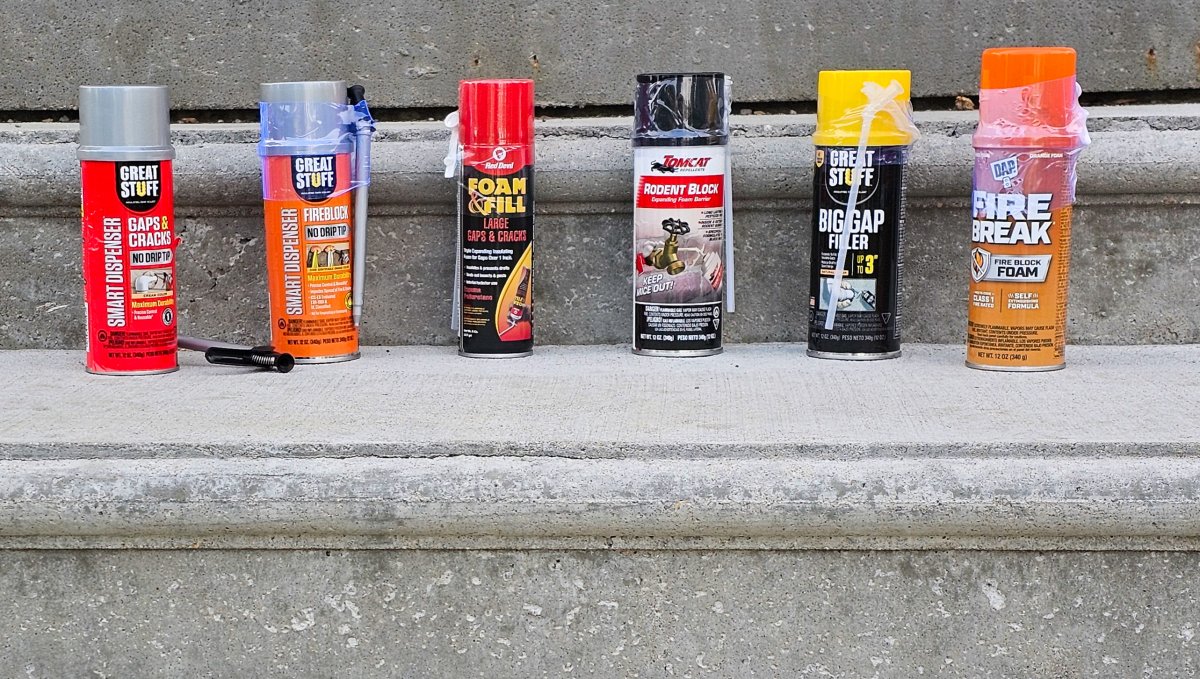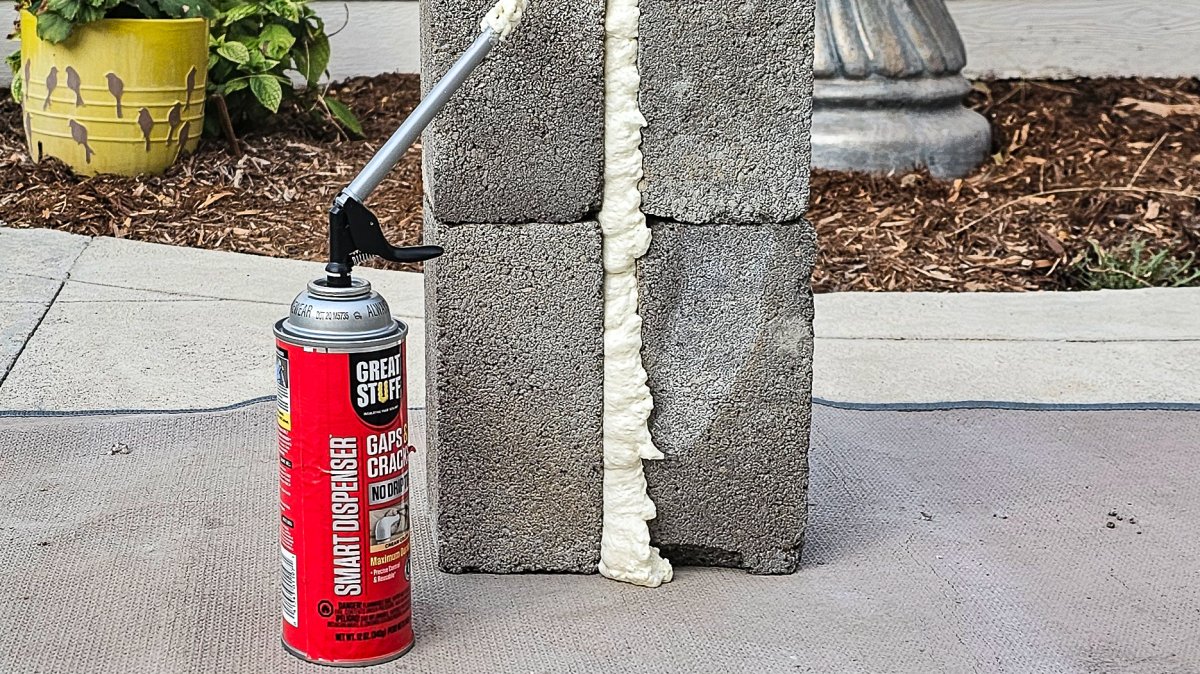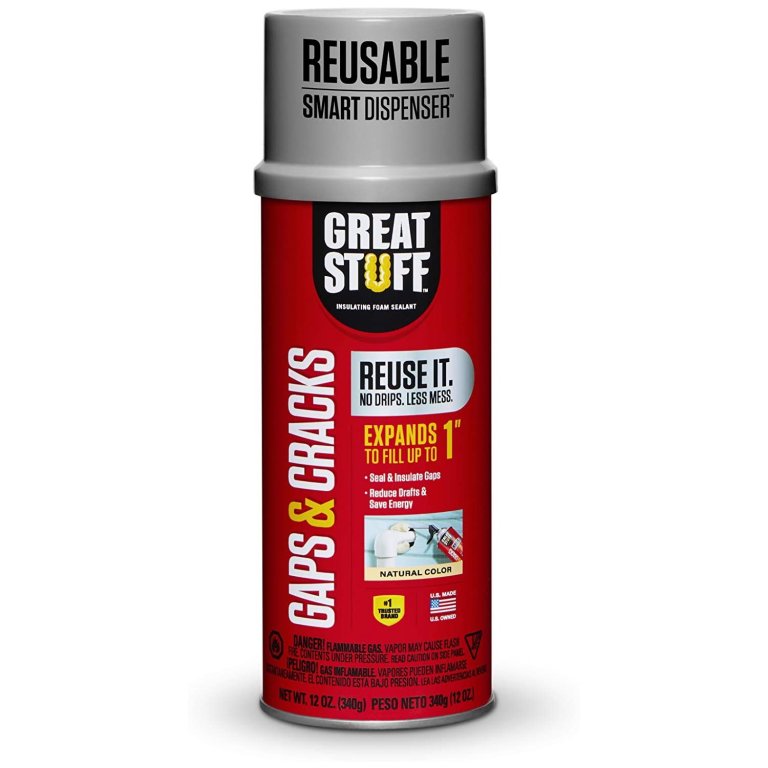
We may earn revenue from the products available on this page and participate in affiliate programs. Learn More ›
In today’s DIY and construction industries, expanding foam is frequently used to insulate against drafts, keep water pipes from banging, and even bring walls up to fire code. We tested six leading brands of expanding foam spray and found a favorite: Great Stuff Gaps and Cracks Foam. While all the brands we tested performed well, Gaps and Cracks flowed easily without dripping, expanded uniformly, wasn’t overly aggressive, and was easy to trim with a serrated knife.
If you need to seal some gaps or stabilize some pipes around your house, expanding foam might be the solution you’re looking for. But check out our shopping tips before you buy because certain types are better suited for specific applications. And find out why we chose Great Stuff Gaps and Cracks as the best expanding foam for most DIYers.

| Testing Stats | |
| Products tested | 6 |
| Time spent testing | 2.5 hours |
| Tests performed | 3 |
| Price range | $8 to $11 per can |
Best Overall
Great Stuff Gaps and Cracks Expanding Foam
What We Like
- Tapered tube makes it easy to direct the foam
- Foam was not overly aggressive
- Dries completely in a couple of hours
- Cuts smoothly with a serrated blade
What We Don’t Like
- Foam is likely to clog the tube if left unused for a couple of hours
Product Specs
- Maximum gap size: Up to 1 inch
- Tip type: Screw-on Smart Dispenser
- Compatible materials: Wood, metal, masonry, glass, and most plastics
Like the other cans of expandable foam we tested, Great Stuff Gaps and Cracks comes with a dispensing tube. The nice thing about this tube is that it’s rigid and tapers to a point, which made it simple to direct the foam where we wanted it. Some of the other cans had thin, flexible tubes, which required holding the tube with one hand while depressing the spray trigger of the can.
We shook the can for what seemed like forever but was really just one full minute, as suggested by the manufacturer to fully mix the contents. We then dispensed the foam along a framed door, in various-size slots cut into wood paneling, and between closely aligned cinder bricks. Over the next 10 minutes or so, Gaps and Cracks reached its maximum expansion, and in a couple of hours, it was dry to the touch. It adhered strongly, and we couldn’t pull the cinder bricks apart.
We then used a serrated blade from a reciprocating saw to cut away the excess foam from the cinder bricks. It cut smoothly and left a level surface, which is vital for installing drywall or siding over foam-filled gaps. Lastly, Gaps and Cracks wasn’t overly aggressive, meaning it didn’t exert undue pressure on the wood next to the gaps we filled. This is important if you’re filling gaps beside windows and doors because high-expansion foam has been known to push the framing material out of alignment, making it difficult to open and close windows and doors.
Get the Great Stuff Gaps & Cracks expanding foam at Amazon, Lowe’s, Tractor Supply Co., or The Home Depot.
More Expanding Foams Worth Your Money
While Great Stuff Gaps and Cracks earned the top honor in our tests, the following expanding foam brands also performed well. Depending on your gap-filling needs, one is sure to be right for you.
- DAP Max Fill Large Gap Triple Expanding Foam Sealant
- Great Stuff Big Gap Filler With Original Dispenser
- Red Devil Foam & Fill Large Gaps & Cracks Sealant
- Tomcat Rodent Block Expanding Foam Barrier
- Great Stuff Fireblock Foam Sealant
How We Tested the Best Expanding Foams
We selected the expanding foams for our test based on several factors. We considered the brand to an extent, because names like Great Stuff and Red Devil are highly respected in the expanding foam industry. Then, we opted to test foam products for various uses, such as sealing out rodents, filling large gaps, or meeting fire code requirements.
Our testing was straightforward. We used each expanding foam product as recommended by the manufacturer. That meant shaking the cans vigorously for a minute, attaching the dispensing tubes, and spraying the foam in gaps in test boards and masonry. We noted the amount of expansion and whether we could trim away excess foam easily. We also closely examined how well the cured foam adhered to the materials and whether it sealed all voids.
What to Consider When Choosing an Expanding Foam
When shopping for expanding foam, the primary consideration is what you’re planning to seal. Sizeable gaps may require a high-expansion foam, while sealing around windows and doors usually calls for a minimal expanding foam. You’ll also want to consider location since not all indoor foam products are suitable for outdoor applications. Fortunately, expanding foam manufacturers are good about listing the specific uses for their products right on the cans.
Gap Size: High vs. Low Expansion
Expanding foam products fall into two broad categories based on the amount that they can expand beyond the liquid size: high-expansion foam, installed by insulation pros, and low-expansion foam, suitable for DIY use.
- High-expansion foam is typically used in commercial and industrial settings to quickly fill gaps and cracks in doorways and windows. It is also regularly used for filling holes in the foundation and mortar where water, gas, and electrical lines have been run. This type of expanding foam can expand up to 200 to 300 times its liquid size. It can include open-cell foam, which allows moisture to flow through the foam, and closed-cell foam, which completely blocks moisture and airflow. It is most often used by spray foam insulation contractors.
- Low-expansion foam, in contrast, can only expand up to 20 to 30 times its liquid size. This smaller size makes low-expansion foam a great choice for home repairs because the gaps, cracks, and utility holes are generally much smaller. This is the type of foam best suited to filling the voids in framing around doors and windows.
Functionality and Use
Most people use expanding foam for its versatile formulas, including waterproofing, fireproofing, acoustic insulating, and thermal insulating.
- Waterproofing expanding foam is commonly used around the home. Sealing cracks and gaps in the foundation, walls, and around windows and doors helps prevent water from leaking into the home. Some expanding foam products can even be used to help create ponds, fountains, and other water features for the yard.
- Fireproofing foam is required by fire code to fill gaps in 1- or 2-hour fire walls. The foam is used to seal spaces around wires and pipes and gaps around wall outlet boxes. It serves as a fire barrier to slow the spread of fire from one side of the wall to the other.
- Acoustic insulating foam reduces noise transfer between rooms, floors, and exterior walls. It comes in both high and low expansion varieties.
- Thermal insulating can be done with high-expansion foam, but this is typically a job for trained pros certified in applying the expanding insulation foam uniformly between wall studs and rafter spaces.
Application
Expanding foam products will typically come prepared for use in a spray can or in separate components that need to be applied with a handheld gun.
- Spray cans are easy to use. The solu
- tion comes premixed, so there is no wait time before the expanding foam can be applied, but the cans typically require vigorous shaking. These products usually come with a long, narrow dispenser that connects to the nozzle, allowing the foam to be injected into very small gaps with accuracy. Remember to hold the can upside down during application, which ensures uniform coverage.
- Handheld guns require more knowledge and experience to use with precision but are the best option for professional projects like insulating the attic. These products typically include two separated components in pressurized tanks. The handheld gun has two hoses and connects to both tanks. When the user is ready, the tank valves are opened, allowing the expanding foam to be sprayed through the gun’s nozzle.
FAQs
Expanding foam products are designed to seal cracks and gaps, secure plumbing and wiring, and block rodents and other pests from entering the home. Below are the answers to some of the most commonly asked questions about how to use expanding foam and the dangers it can pose.ergic reactions can occur.
The terms are used interchangeably, but technically, spray foam is any foam that is applied as a spray and includes DIY-friendly cans and industrial foam insulation that’s applied with professional equipment. Expanding foam is typically used to describe the foam products that come in user-friendly cans. For our testing, all products were cans of expanding foam.
Expanding foam insulation (high-expansion) expands the most and is well suited to large projects. It’s capable of expanding 200 to 300 times the liquid size. A good example is Icynene, a professionally applied solution used to insulate walls and ceilings.
Yes, some expanding foam is designed to be waterproof. Certain products are even made specifically for building ponds, fountains, and other outdoor water features. For added convenience, those waterproof expanding foams are also made to withstand harmful ultraviolet rays to ensure maximum longevity and durability.
Expanding foam isn’t a good idea for every area of the house. Avoid spraying expanding foam too close to electrical boxes or light boxes where the foam can pose a fire hazard, unless it is specifically designed for this purpose. Also avoid using open-cell spray foam on the roof because it can cause moisture to accumulate, rotting out the roofing. If you aren’t sure whether to use expanding foam for a specific problem or in a specific area, check with the manufacturer before using it.
Expanding foam needs to be applied with proper ventilation and breathing protection because the chemicals produced by the spray foam vapor can trigger asthma, eye irritation, itching, and rashes. If proper protection is not worn, irritation and even allergic reactions can occur.
Meet the Tester
Glenda Taylor is a product tester and writer specializing in the construction, remodeling, and real estate industries. She and her husband own a general contracting company, and Taylor is experienced in both residential and commercial building applications. She tests a wide range of power tools as well as other home improvement, household, and lawn-and-garden products.
Additional research provided by Timothy Dale.


